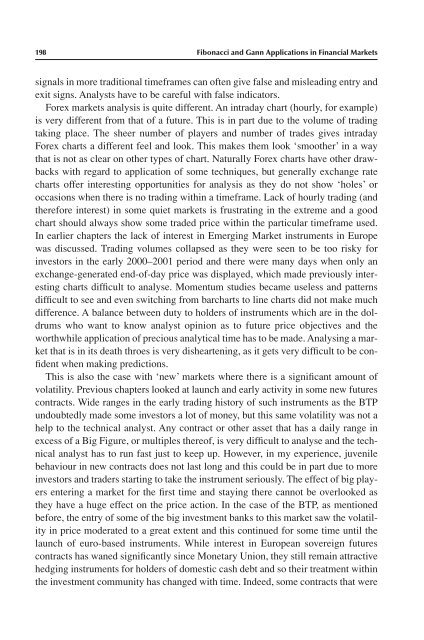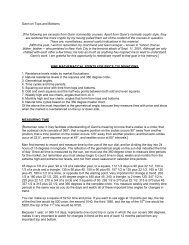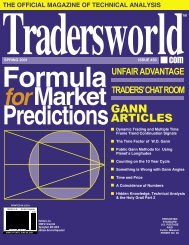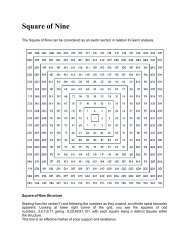Fibonacci and Gann Applications in Financial Markets
Fibonacci and Gann Applications in Financial Markets
Fibonacci and Gann Applications in Financial Markets
You also want an ePaper? Increase the reach of your titles
YUMPU automatically turns print PDFs into web optimized ePapers that Google loves.
198 <strong>Fibonacci</strong> <strong>and</strong> <strong>Gann</strong> <strong>Applications</strong> <strong>in</strong> F<strong>in</strong>ancial <strong>Markets</strong><br />
signals <strong>in</strong> more traditional timeframes can often give false <strong>and</strong> mislead<strong>in</strong>g entry <strong>and</strong><br />
exit signs. Analysts have to be careful with false <strong>in</strong>dicators.<br />
Forex markets analysis is quite different. An <strong>in</strong>traday chart (hourly, for example)<br />
is very different from that of a future. This is <strong>in</strong> part due to the volume of trad<strong>in</strong>g<br />
tak<strong>in</strong>g place. The sheer number of players <strong>and</strong> number of trades gives <strong>in</strong>traday<br />
Forex charts a different feel <strong>and</strong> look. This makes them look ‘smoother’ <strong>in</strong> a way<br />
that is not as clear on other types of chart. Naturally Forex charts have other drawbacks<br />
with regard to application of some techniques, but generally exchange rate<br />
charts offer <strong>in</strong>terest<strong>in</strong>g opportunities for analysis as they do not show ‘holes’ or<br />
occasions when there is no trad<strong>in</strong>g with<strong>in</strong> a timeframe. Lack of hourly trad<strong>in</strong>g (<strong>and</strong><br />
therefore <strong>in</strong>terest) <strong>in</strong> some quiet markets is frustrat<strong>in</strong>g <strong>in</strong> the extreme <strong>and</strong> a good<br />
chart should always show some traded price with<strong>in</strong> the particular timeframe used.<br />
In earlier chapters the lack of <strong>in</strong>terest <strong>in</strong> Emerg<strong>in</strong>g Market <strong>in</strong>struments <strong>in</strong> Europe<br />
was discussed. Trad<strong>in</strong>g volumes collapsed as they were seen to be too risky for<br />
<strong>in</strong>vestors <strong>in</strong> the early 2000–2001 period <strong>and</strong> there were many days when only an<br />
exchange-generated end-of-day price was displayed, which made previously <strong>in</strong>terest<strong>in</strong>g<br />
charts difficult to analyse. Momentum studies became useless <strong>and</strong> patterns<br />
difficult to see <strong>and</strong> even switch<strong>in</strong>g from barcharts to l<strong>in</strong>e charts did not make much<br />
difference. A balance between duty to holders of <strong>in</strong>struments which are <strong>in</strong> the doldrums<br />
who want to know analyst op<strong>in</strong>ion as to future price objectives <strong>and</strong> the<br />
worthwhile application of precious analytical time has to be made. Analys<strong>in</strong>g a market<br />
that is <strong>in</strong> its death throes is very dishearten<strong>in</strong>g, as it gets very difficult to be confident<br />
when mak<strong>in</strong>g predictions.<br />
This is also the case with ‘new’ markets where there is a significant amount of<br />
volatility. Previous chapters looked at launch <strong>and</strong> early activity <strong>in</strong> some new futures<br />
contracts. Wide ranges <strong>in</strong> the early trad<strong>in</strong>g history of such <strong>in</strong>struments as the BTP<br />
undoubtedly made some <strong>in</strong>vestors a lot of money, but this same volatility was not a<br />
help to the technical analyst. Any contract or other asset that has a daily range <strong>in</strong><br />
excess of a Big Figure, or multiples thereof, is very difficult to analyse <strong>and</strong> the technical<br />
analyst has to run fast just to keep up. However, <strong>in</strong> my experience, juvenile<br />
behaviour <strong>in</strong> new contracts does not last long <strong>and</strong> this could be <strong>in</strong> part due to more<br />
<strong>in</strong>vestors <strong>and</strong> traders start<strong>in</strong>g to take the <strong>in</strong>strument seriously. The effect of big players<br />
enter<strong>in</strong>g a market for the first time <strong>and</strong> stay<strong>in</strong>g there cannot be overlooked as<br />
they have a huge effect on the price action. In the case of the BTP, as mentioned<br />
before, the entry of some of the big <strong>in</strong>vestment banks to this market saw the volatility<br />
<strong>in</strong> price moderated to a great extent <strong>and</strong> this cont<strong>in</strong>ued for some time until the<br />
launch of euro-based <strong>in</strong>struments. While <strong>in</strong>terest <strong>in</strong> European sovereign futures<br />
contracts has waned significantly s<strong>in</strong>ce Monetary Union, they still rema<strong>in</strong> attractive<br />
hedg<strong>in</strong>g <strong>in</strong>struments for holders of domestic cash debt <strong>and</strong> so their treatment with<strong>in</strong><br />
the <strong>in</strong>vestment community has changed with time. Indeed, some contracts that were






